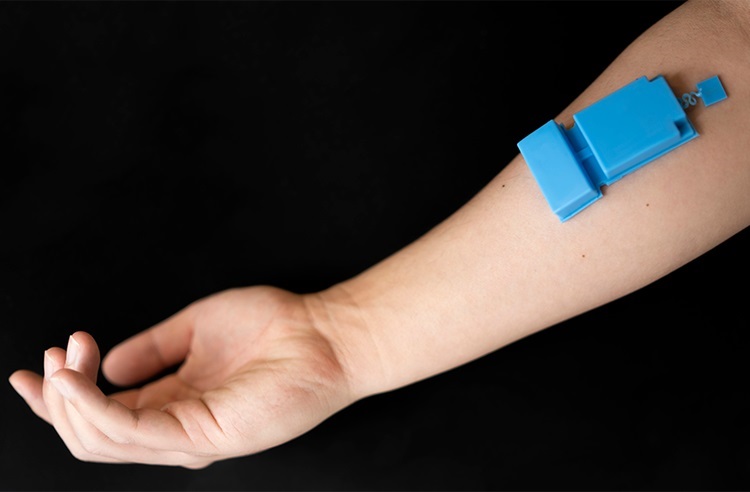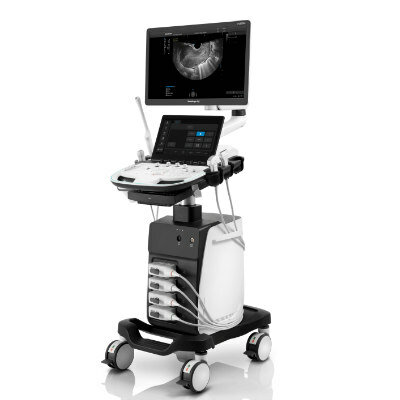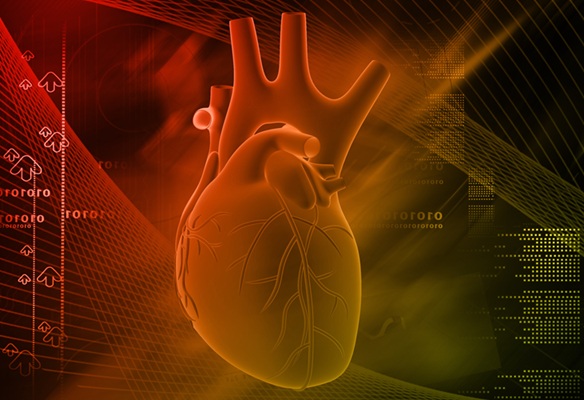Wearable Ultrasound Device Provides Long-Term, Wireless Muscle Monitoring 
|
By MedImaging International staff writers Posted on 01 Nov 2024 |

Electromyography (EMG) is the current clinical standard for monitoring muscle activity, utilizing metal electrodes placed on the skin to capture electrical signals from muscles. Despite its long-standing use, EMG faces challenges such as low resolution and weak signals. For instance, signals from multiple muscle fibers often blend, complicating the isolation of contributions from individual fibers. On the other hand, ultrasound offers high-resolution imaging that penetrates deep tissues, providing detailed insights into muscle function. Now, researchers have introduced a new wearable ultrasound technology for muscle monitoring that could serve as a promising alternative to EMG.
Engineers at the University of California San Diego (La Jolla, CA, USA) have created a wearable ultrasound device capable of long-term, wireless monitoring of muscle activity, with potential applications in healthcare and human-machine interfaces. The device is encased in flexible silicone elastomer and includes three main components: a single transducer for sending and receiving ultrasound waves, a custom-designed wireless circuit that controls the transducer, records data, and transmits it to a computer, and a lithium-polymer battery that provides power for at least three hours. Designed to adhere to the skin with an adhesive layer, the device allows for high-resolution tracking of muscle function without the need for invasive procedures. Additionally, the ultrasound technology is compact, wireless, and energy-efficient.
A significant innovation of this work is the utilization of a single ultrasound transducer to effectively sense deep tissues. This transducer emits intensity-controlled ultrasound waves and captures radiofrequency signals rich in information, enabling clinical applications such as measuring diaphragm thickness. By leveraging these signals, the device achieves high spatial resolution, which is essential for isolating specific muscle movements. To gain further insights from these signals, the researchers developed an artificial intelligence algorithm that maps the signals to their corresponding muscle distributions, allowing it to accurately identify specific hand gestures from the collected data.
In tests, the device was worn over the rib cage to monitor diaphragm motion and thickness, critical metrics for evaluating respiratory health. When worn on the rib cage, the device was able to measure diaphragm thickness with submillimeter precision. This measurement is clinically significant for assessing diaphragm dysfunction and predicting outcomes in ventilated patients. Additionally, by analyzing muscle motion, the researchers could differentiate between various breathing patterns, such as shallow versus deep breaths, which could aid in diagnosing conditions related to respiratory irregularities, including asthma, pneumonia, and chronic obstructive pulmonary disease (COPD). In a small trial, the device successfully distinguished the breathing patterns of individuals with COPD from those of healthy participants.
Furthermore, in research published in Nature Electronics, the team demonstrated the device's application on the forearm to capture hand and wrist muscle activity, enabling its use as a human-machine interface for controlling a robotic arm and playing a virtual game. When used on the forearm, the device precisely tracked muscle motion in the hands and wrists. Thanks to the artificial intelligence algorithm, the system can recognize various hand gestures based solely on ultrasound signals. It can identify 13 degrees of freedom, covering 10 finger joints and three wrist rotation angles, thus capturing even minor movements with high sensitivity. In proof-of-concept tests, participants controlled a robotic arm to pipette water into beakers and played a virtual game, steering a virtual bird through obstacles using wrist movements. Going forward, the researchers aim to enhance the technology’s accuracy, portability, energy efficiency, and computational capabilities.
Latest Ultrasound News
- Wireless Chronic Pain Management Device to Reduce Need for Painkillers and Surgery
- New Medical Ultrasound Imaging Technique Enables ICU Bedside Monitoring
- New Incision-Free Technique Halts Growth of Debilitating Brain Lesions
- AI-Powered Lung Ultrasound Outperforms Human Experts in Tuberculosis Diagnosis
- AI Identifies Heart Valve Disease from Common Imaging Test
- Novel Imaging Method Enables Early Diagnosis and Treatment Monitoring of Type 2 Diabetes
- Ultrasound-Based Microscopy Technique to Help Diagnose Small Vessel Diseases
- Smart Ultrasound-Activated Immune Cells Destroy Cancer Cells for Extended Periods
- Tiny Magnetic Robot Takes 3D Scans from Deep Within Body
- High Resolution Ultrasound Speeds Up Prostate Cancer Diagnosis
- World's First Wireless, Handheld, Whole-Body Ultrasound with Single PZT Transducer Makes Imaging More Accessible
- Artificial Intelligence Detects Undiagnosed Liver Disease from Echocardiograms
- Ultrasound Imaging Non-Invasively Tracks Tumor Response to Radiation and Immunotherapy
- AI Improves Detection of Congenital Heart Defects on Routine Prenatal Ultrasounds
- AI Diagnoses Lung Diseases from Ultrasound Videos with 96.57% Accuracy
- New Contrast Agent for Ultrasound Imaging Ensures Affordable and Safer Medical Diagnostics
Channels
Radiography
view channel
AI Detects Fatty Liver Disease from Chest X-Rays
Fatty liver disease, which results from excess fat accumulation in the liver, is believed to impact approximately one in four individuals globally. If not addressed in time, it can progress to severe conditions... Read more
AI Detects Hidden Heart Disease in Existing CT Chest Scans
Coronary artery calcium (CAC) is a major indicator of cardiovascular risk, but its assessment typically requires a specialized “gated” CT scan that synchronizes with the heartbeat. In contrast, most chest... Read moreMRI
view channel
New MRI Technique Reveals Hidden Heart Issues
Traditional exercise stress tests conducted within an MRI machine require patients to lie flat, a position that artificially improves heart function by increasing stroke volume due to gravity-driven blood... Read more
Shorter MRI Exam Effectively Detects Cancer in Dense Breasts
Women with extremely dense breasts face a higher risk of missed breast cancer diagnoses, as dense glandular and fibrous tissue can obscure tumors on mammograms. While breast MRI is recommended for supplemental... Read moreNuclear Medicine
view channel
Novel Bacteria-Specific PET Imaging Approach Detects Hard-To-Diagnose Lung Infections
Mycobacteroides abscessus is a rapidly growing mycobacteria that primarily affects immunocompromised patients and those with underlying lung diseases, such as cystic fibrosis or chronic obstructive pulmonary... Read more
New Imaging Approach Could Reduce Need for Biopsies to Monitor Prostate Cancer
Prostate cancer is the second leading cause of cancer-related death among men in the United States. However, the majority of older men diagnosed with prostate cancer have slow-growing, low-risk forms of... Read moreGeneral/Advanced Imaging
view channel
CT Colonography Beats Stool DNA Testing for Colon Cancer Screening
As colorectal cancer remains the second leading cause of cancer-related deaths worldwide, early detection through screening is vital to reduce advanced-stage treatments and associated costs.... Read more
First-Of-Its-Kind Wearable Device Offers Revolutionary Alternative to CT Scans
Currently, patients with conditions such as heart failure, pneumonia, or respiratory distress often require multiple imaging procedures that are intermittent, disruptive, and involve high levels of radiation.... Read more
AI-Based CT Scan Analysis Predicts Early-Stage Kidney Damage Due to Cancer Treatments
Radioligand therapy, a form of targeted nuclear medicine, has recently gained attention for its potential in treating specific types of tumors. However, one of the potential side effects of this therapy... Read moreImaging IT
view channel
New Google Cloud Medical Imaging Suite Makes Imaging Healthcare Data More Accessible
Medical imaging is a critical tool used to diagnose patients, and there are billions of medical images scanned globally each year. Imaging data accounts for about 90% of all healthcare data1 and, until... Read more
Global AI in Medical Diagnostics Market to Be Driven by Demand for Image Recognition in Radiology
The global artificial intelligence (AI) in medical diagnostics market is expanding with early disease detection being one of its key applications and image recognition becoming a compelling consumer proposition... Read moreIndustry News
view channel
GE HealthCare and NVIDIA Collaboration to Reimagine Diagnostic Imaging
GE HealthCare (Chicago, IL, USA) has entered into a collaboration with NVIDIA (Santa Clara, CA, USA), expanding the existing relationship between the two companies to focus on pioneering innovation in... Read more
Patient-Specific 3D-Printed Phantoms Transform CT Imaging
New research has highlighted how anatomically precise, patient-specific 3D-printed phantoms are proving to be scalable, cost-effective, and efficient tools in the development of new CT scan algorithms... Read more
Siemens and Sectra Collaborate on Enhancing Radiology Workflows
Siemens Healthineers (Forchheim, Germany) and Sectra (Linköping, Sweden) have entered into a collaboration aimed at enhancing radiologists' diagnostic capabilities and, in turn, improving patient care... Read more




















